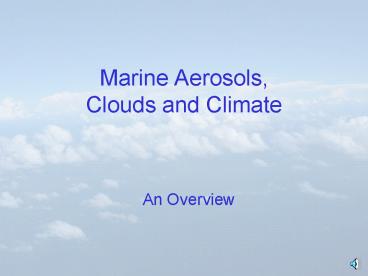Marine Aerosols, Clouds and Climate PowerPoint PPT Presentation
1 / 25
Title: Marine Aerosols, Clouds and Climate
1
Marine Aerosols, Clouds and Climate
- An Overview
2
Definition of Marine Aerosol?
- Natural marine aerosol sea-salt, sulfates,
organics
- Advected marine aerosol soil-dust, sulfates,
organics, black carbon, nitrates. Large amounts,
some deposited to ocean and some transported long
distances
From Husar et al. 1997
3
Distribution of Marine Aerosols
- Northern Hemisphere marine environment is
polluted, even away from major sources
From Heintzenberg et al. 2000
4
Marine Aerosols and Clouds
- Clouds transport and transform marine aerosols,
through chemical and physical processes - Marine clouds cool the surface by reflecting
solar radiation
Modified from Hobbs 2000
5
Marine aerosols Sulfate
- Dimethylsulfide gas from phytoplankton released
to atmosphere produces SO2, H2SO4 eventually
sulfate aerosol - New sulfate aerosol can act as cloud condensation
nuclei, or CCN - Clouds w/ more drops reflect more light, cool
surface--feedback??
CLAW hypothesis, courtesy M. Walkington
6
Marine aerosols Sulfate
- New data suggests sea-salt or clouds scavenge
much of the SO2 produced from DMS. Then converted
to SO42- (internally mixed). Cloud drop N less
affected.
- In regions w/ low sea-salt and clouds, new H2SO4
particles can form (then partially neutralized) - A significant source of new particles is actually
free troposphere near convection, where low
particle surface area and cold temperatures favor
new particle formation - New particles grow and are entrained into
boundary layer, where they can act as new CCN
H2SO4
From Clement et al. 2001
7
New Particle Production in RICO
8
Marine Aerosols Sulfate
- Limited S isotopic measurements of aerosol
indicate less than 35 of S in No Hem is biogenic
From Heintzenberg et al. 2000
9
Marine aerosols Sea-salt
- Sea-salt in various sizes produced by bubbles
breaking waves
- Hygroscopic, liquid at high humidity and can
dominate light scattering in remote areas (direct
effect)
From O'Dowd et al. 1997
10
Marine aerosols Sea-salt
- Submicron sea-salt important in increasing
number of droplets - Large and "giant" sea salt low in conc. but
important in forming large cloud drops, which
deplete water through drizzle
11
Sea-salt Effects of Giant Nuclei
- Giant sea-salt particles produced by high wind
speeds are predicted to dramatically increase
rain rate
From Jensen, 2004
Anthropogenic giant nuclei?
12
Marine aerosols Sea-salt/Sulfate
- SO2 is taken up by sea-salt aerosol and by cloud
drops formed on sea-salt and is converted to
sulfate ("non-sea-salt sulfate"). "Internally
mixed" aerosol is mix of sea-salt and NSS-sulfate.
- Smaller sea-salt particles have higher
surface/volume ratio and so react more quickly w/
avail. SO2 - This reactivity is important for clouds and
climate
.04 ?m
5 ?m
13
Marine aerosols Sea-salt/Sulfate
- Internal mixing of sea-salt sulfate is
important because it reduces the number of
potential new aerosol particles, which reduces
cloud drop number
From O'Dowd et al. 1999
14
Marine aerosols Organics
- Large amount of aerosol mass may be organic, esp.
in So Hem. - Wide open research area, speciation and
cloud-forming abilities virtually unknown
- Truth or fiction? Organic coatings on sea-salt
or sulfate CCN may slow droplet growth and reduce
cloud-forming ability
15
Marine Aerosols Organics
- Some natural organics, by also produced by
industry, biomass, transported long distances - Organics mix w/ sulfate in polluted regions
Courtesy Jim Anderson, ASU
16
Organics and Clouds
- EELS reveals that some nuclei primarily C, with
smaller amounts of N and S
- Cloud droplets downwind of India evaporated and
their nuclei analyzed by electron microscopy
- At least some organic aerosols are good cloud
nuclei, challenge is determining which ones and
incorporating into models
17
Marine Aerosols Dust "The dust falls in such
quantities as to dirty everything on board, and
to hurt people's eyes vessels even have run on
shore owing to the obscurity of the atmosphere".
--Darwin, 1823
From Heintzenberg et al. 2000
18
Marine Aerosols Dust
- Nutrients in soil dust (Fe, Mn) important for
growth of ocean microorganisms - Pathogens may affect coral reefs
- aspergillosis on sea fan
- Dust transported long distances over oceans.
African dust reaches Caribbean even US East
Coast
19
Marine Aerosols Dust
- Soil dust may act as a CCN (if coated w/ soluble
substances) or an ice nucleus - Possible influence on tropical cloud systems?
From Dunion et al. 2004
20
Marine Aerosols, Clouds Climatefirst indirect
aerosol (Twomey) effect
- Marine clouds naturally have low droplet number,
large droplet size, drizzle a lot - Advected marine aerosols perturb this state
- Aerosols act as CCN
- more CCN --gt more, smaller droplets
- Smaller drops reflect more sunlight (increase
cloud reflectance or albedo), cool earth. Assumes
constant liquid water path - One of largest uncertainties in prediction of
global climate change
21
Marine Aerosols, Clouds ClimateIs indirect
effect valid for marine stratus?DYCOMS-II expt,
NE Pacific
22
DYCOMS-II Expt., NE Pacific
23
DYCOMS-II Expt., NE Pacific
- Polluted clouds have smaller, more numerous
drops, but are they more reflective? - Variations in liquid water path obscure cloud
brightening effect of increased aerosol (Cotton
seminar)
24
Summary
- Ocean important source of sea-salt, sulfate
aerosol, but advected aerosols dominate over much
of Northern Hemisphere oceans - Atm. chemistry, ocean productivity and cloud
properties are perturbed by these advected
aerosols - Interactions between these aerosol types
important - Increased aerosol DOES affect marine cloud
properties (increase number, decrease size of
drops). However, liquid water path differences
may act to partially offset cooling effect on
climate.
25
Areas Needing Research
- Organic aerosols source (natural vs.
anthropogenic), speciation, water solubility,
mixing state, new particle formation - Sea-salt size distribution, mixing state w/
sulfate and/or organics, giant nuclei N conc. - Sulfates source (isotopic measurements), mixing
state w/ sea-salt, organics - Dust impact on cloud formation, amount deposited
to oceans, role of different nutrients and impact
on ocean productivity

